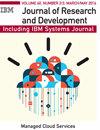IBM Z development transformation
IF 1.3
4区 计算机科学
Q1 Computer Science
引用次数: 0
Abstract
This article discusses how the product development cycle is being transformed with “Artificial Intelligence” (AI) for the first time in zSeries history. This new era of AI, under the project name IBM Z Development Transformation (zDT), has allowed the team to grow and learn new skills in data science. This transformation forces change structurally in how data is prepared and stored. In z14, there were incremental productivity gains with enhancements to automation with eServer Automation Test Solution and a technology data analysis engine called zDataAssist. However, in z15, AI will significantly accelerate our efficiency. This article explains how Design Thinking and Agile principles were used to identify areas that are of high impact and feasible to implement: 1) what and how data is collected via System Test Event Logging and Analysis engine, Problem ticket management system (Jupitr), and Processor data analysis engine (Xrings); 2) problem identification, analysis, and management (AutoJup) along with Intelligent Recovery Verification Assistant; 3) product design documentation search engine (AskTheMachine); and 4) prototype microprocessor allocation processes Intelligent Commodity Fulfillment System using Machine Learning. This article details the approach of these areas for z15, the implementation of these solutions under the zDT project, as well as the results and future work.IBM Z开发转型
本文讨论了zSeries历史上第一次如何用“人工智能”(AI)来改变产品开发周期。这个人工智能的新时代,以IBM Z Development Transformation(zDT)的项目名称,让团队得以成长和学习数据科学的新技能。这种转换迫使数据的准备和存储方式在结构上发生变化。在z14中,通过eServer automation Test Solution和一个名为zDataAssist的技术数据分析引擎对自动化的增强,生产力得到了提高。然而,在z15中,人工智能将显著提高我们的效率。本文解释了如何使用设计思维和敏捷原则来确定具有高影响和可行实施的领域:1)通过系统测试事件日志记录和分析引擎、问题单管理系统(Jupitr)和处理器数据分析引擎(Xrings)收集什么和如何收集数据;2) 问题识别、分析和管理(AutoJup)以及智能恢复验证助手;3) 产品设计文档搜索引擎(AskTheMachine);以及4)使用机器学习的原型微处理器分配处理智能商品履行系统。本文详细介绍了z15的这些领域的方法,zDT项目下这些解决方案的实现,以及结果和未来的工作。
本文章由计算机程序翻译,如有差异,请以英文原文为准。
求助全文
约1分钟内获得全文
求助全文
来源期刊

IBM Journal of Research and Development
工程技术-计算机:硬件
自引率
0.00%
发文量
0
审稿时长
6-12 weeks
期刊介绍:
The IBM Journal of Research and Development is a peer-reviewed technical journal, published bimonthly, which features the work of authors in the science, technology and engineering of information systems. Papers are written for the worldwide scientific research and development community and knowledgeable professionals.
Submitted papers are welcome from the IBM technical community and from non-IBM authors on topics relevant to the scientific and technical content of the Journal.
 求助内容:
求助内容: 应助结果提醒方式:
应助结果提醒方式:


